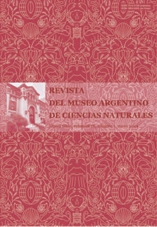Biología de nidificación de la especie eusocial primitiva Augochlora phoemonoe (Halictidae)
Resumen
Se describe la biología de nidificación de la especie eusocial primitiva Augochlora phoemonoe a partir de observaciones de nidos hallados en el campo y nidos artificiales mantenidos en laboratorio. La especie nidifica en madera en descomposición, aunque puede aceptar otro sustrato como el yeso. Se encontraron dos tipos de estructuras de nidificación: celdas apoyadas al sustrato sin cavidad circundante y celdas dispuestas en forma de racimo rodeadas por una cavidad y sostenidas por un número variable de pilares. Ambas estructuras presentaron un orificio de entrada rodeado por un anillo de partículas de madera compactadas y un túnel no ramificado que conduce a las celdas. La hembra fundadora comienza el nido en forma solitaria. Hace primero el orificio de entrada y un túnel no ramificado, luego construye la o las primeras celdas. Las hembras hijas son las que continúan el proceso de construcción del nido durante la etapa social. Se describen procesos de remoción y transporte de partículas de madera y de construcción de túnel, cavidades y celdas. Los hallazgos del presente estudio aportan caracteres para la clasificación de las estructuras de nidificación y el análisis filogenético dentro de Augochlorini.
Palabras clave
Texto completo:
PDFReferencias
Barrows, E.M. 1973. Soil nesting by wood-inhabiting halictine bees, Augochlora pura and Lasioglossum coeruleum (Hymenoptera: Halictidae). Journal of the Kansas Entomological Society 46 (4): 496-499.
Batra, S.W.T. 1964. Behavior of the social bee, Lasioglossum zephyrum, within the nest (Hymenoptera: Halictidae). Insectes Sociaux 11 (2): 159-186.
Brosi, B.J.; Smith-Pardo, A.H. & V.H. Gonzalez. 2006. A new wood-nesting Neocorynura (Hymenoptera: Halictidae: Augochlorini) from Costa Rica, with notes on its biology. Zootaxa 1189: 55-68.
Dalmazzo, M. & A. Roig-Alsina. 2011. Revision of the species of the New World genus Augochlora (Hymenoptera, Halictidae) occurring in the southern temperate areas of its range. Zootaxa 2750: 15–32.
Dalmazzo, M. & A. Roig-Alsina. 2012. Nest structures and notes on social behavior of Augochlora amphitrite (Schrottky) (Hymenoptera, Halictidae). Journal of Hymenoptera Research 26: 17–29.
Dalmazzo, M. & A. Roig-Asina. 2015. Social biology of Augochlora (Augochlora) phoemonoe (Hymenoptera, Halictidae) reared in laboratory nests. Insectes Sociaux 62: 315-323.
Danforth, B.N. & G.C. Eickwort. 1997. The evolution of social behavior in the augochlorine sweat bees (Hymenoptera: Halictidae) based on a phylogenetic analysis of the genera. En: Choe, J.C. & B.J. Crespi (eds.) The evolution of social behavior in insects and arachnids, pp. 270-292, Cambridge University Press.
Eickwort, G.C. 1969. Tribal positions of Western Hemisphere green sweat bees, with comments on their nest architecture (Hymenoptera: Halictidae). Annals of the Entomological Society of America 62: 652-660.
Eickwort, G.C. & S.F. Sakagami. 1979. A classification of nest architecture of bees in the tribe Augochlorini (Hymenoptera: Halictidae; Halictinae), with description of a Brazilian nest of Rhinocorynura inflaticeps. Biotropica 11: 28-37.
Engel, M.S. 2000. Classification of the bee tribe Augochlorini (Hymenoptera: Halictidae). Bulletin of the American Museum of Natural History 1-90.
Garibaldi, L.A.; Steffan-Dewenter, I.; Winfree, R.; Aizen, M.A.; Bommarco, R.; Cunningham, S.A.; et al. 2013. Wild pollinators enhance fruit set of crops regardless of honey bee abundance. Science 339(6127): 1608-1611.
Kiverling, M.A. 2001. Flora fanerógama de la Reserva Ecológica de la Ciudad Universitaria Paraje El Pozo. Santa Fe, Argentina” Tesina de Licenciatura en Biodiversidad. Universidad Nacional del Litoral
Michener, C.D. 2007. The bees of the world. 2nd Ed. Johns Hopkins University Press, Baltimore y Londres.
Moure, J.S. 2007. Augochlorini Beebe, 1925. En: Moure, J.S.; Urban, D. & G.A.R Melo (eds.) Catalogue of bees (Hymenoptera, Apoidea) in the Neotropical Region. Sociedade Brasilera de Entomología. Curitiba.
Peters, V.E.; Carroll, C.R.; Cooper, R.J.; Greenberg, R.; & M. Solis. 2013. The contribution of plant species with a steady-state flowering phenology to native bee conservation and bee pollination service. Insect Conservation and Diversity 6: 45–46.
Pitts Singer, T.L. & J.H. Cane. 2011. The alfalfa leafcutting bee Megachile rotundata: the world´s most intensively managed solitary bee. Annual Review of Entomology 56: 221-237.
Sakagami, S.F. & C.D. Michener. 1962. The nest architecture of the sweet bees (Halictinae), a comparative study. University of Kansas Press, Lawrence.
Slaa, E.J.; Sanchez-Chaves, L.A.; Malagodi-Braga, K.S. & F.E. Hofstede. 2006. Stingless bees in applied pollination: practice and perspectives. Apidologie 37: 293-315.
Stockhammer, K.A. 1966. Nesting habit and life cycle of a sweet bee, Augochlora pura. Journal of the Kansas Entomological Society 39: 157-192.
Tierney, S.M.; Gonzales-Ojeda, T. & W.T. Wcislo. 2008a. Nesting biology and social behavior of Xenochlora bees (Hymenoptera: Halictidae: Augochlorini) from Perú. Journal of the Kansas Entomological Society 81(1): 61-72.
Tierney, S.M.; Gonzales-Ojeda, T. & W.T. Wcislo. 2008b. Biology of a nocturnal bee, Megalopta aptra (Hymenoptera: Halictidae: Augochlorini), from the Panamanian highlands. Journal of Natural History 42(27-28): 1841-1847.
Tierney, S.M.; Sanjur, O.; Grajales, G.G.; Santos, L.M.; Bermingham, E. & W.T. Wcislo. 2012. Photic niche invasions: phylogenetic history of the dim-light foraging augochlorine bees (Halictidae). Proceedings of the Royal Society B 279 (1729): 794-803.
Velthuis, H.H.W. & A. van Doorm. 2006. A century of advances in bumble bee domestication and the economic and environmental aspect of its commercialization for pollination. Apidologie 37 (4): 421-451.
Waser, N.M. & J. Ollerton (eds.) 2006. Plant-pollinator interactions. From specialization to generalization. University Chicago Press, Chicago and London.
Wcislo, W.T.; González, V.H. & M. S. Engel. 2003. Nesting and social behavior of a wood-dwelling Neotropical bee, Augochlora isthmii (Schwarz), and notes on a new species, A. alexanderi Engel (Hymenoptera: Halictidae). Journal of the Kansas Entomological Society 76(4): 588-602.
Zillikens, A.; Steiner, J. & Z. Mihalkó. 2001. Nest of Augochlora (A.) esox in bromeliads, a previously unknown site for sweat bees (Hymenoptera: Halictidae). Studies on Neotropical Fauna and Environment 36(2): 137-142.
Enlaces refback
- No hay ningún enlace refback.

This work is licensed under a Creative Commons Attribution 3.0 License.

